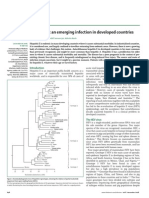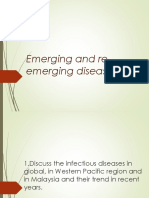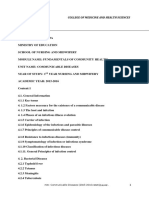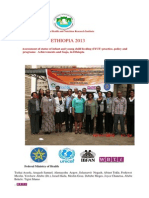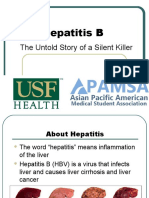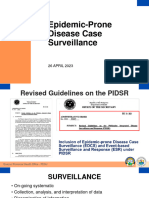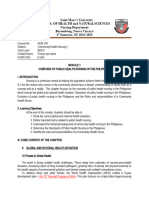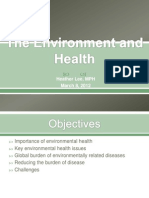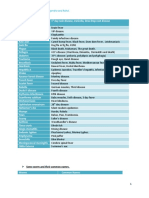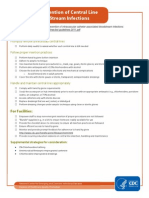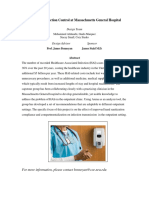Hepatitis e
Hepatitis e
Uploaded by
BobdCopyright:
Available Formats
Hepatitis e
Hepatitis e
Uploaded by
BobdOriginal Description:
Copyright
Available Formats
Share this document
Did you find this document useful?
Is this content inappropriate?
Copyright:
Available Formats
Hepatitis e
Hepatitis e
Uploaded by
BobdCopyright:
Available Formats
Communicable Diseases Factsheet
Hepatitis E is a viral infection that affects the liver. Infection usually occurs after drinking faecallycontaminated water. Most infections in Australia
Hepatitis E
Issued: 1 July 2013
are contracted whilst travelling in developing countries. Infection can be prevented by avoiding drinking untreated water and thoroughly cooking meat.
What is Hepatitis E?
Hepatitis means inflammation or swelling of the liver. It can be caused by chemicals or drugs, or by different kinds of viral infection. Hepatitis E is caused by the hepatitis E virus and most people recover after several days or weeks. It can be serious in pregnant women, especially during the third trimester, in infants, and in people who have pre-existing chronic liver disease.
What are the symptoms?
The symptoms of hepatitis E include: nausea vomiting tiredness abdominal/gut pain fever dark urine pale stools loss of appetite joint pain yellowing of skin and eyeballs (jaundice).
Symptoms develop on average 3 to 6 weeks after the infection, though this differs between people and can be anywhere from 15 to 64 days after infection. Some people, especially children, have no symptoms but can still spread the virus to others. Hepatitis E can worsen chronic liver disease. Occasionally, hepatitis E can cause acute liver failure, which can lead to death.
How is it spread?
Hepatitis E is common in developing countries where there is poor sanitation and little access to clean water. It can be spread though exposure to: drinking untreated water eating food prepared by an infected person eating raw shellfish that has been contaminated by sewerage or eating insufficiently cooked meat, especially pork vertical transmission from a pregnant woman to her baby
Hepatitis E
page 1 of 3
direct contact with an infected person such as a household member or sexual partner, or in child care or health care settings (although person-to-person transmission of hepatitis E is uncommon).
The infectious period of hepatitis E is usually up to 2 weeks after the onset of symptoms, but the virus has been detected in the stools of an infected individual up to 6 weeks after the onset of symptoms.
Who is at risk?
People who live in or travel to developing countries are at most risk. The virus is common in many parts of central and south-east Asia, the Middle East and Africa, the Mediterranean region, Mexico and South America. Over 60% of all hepatitis E infections occur in East and South Asia.
How is it prevented?
When travelling to developing countries: use bottled or boiled water (for drinking and brushing your teeth). do NOT consume untreated water or ice. only eat fruit or vegetables that you peel yourself and food that is freshly cooked and piping hot.
Wash your hands thoroughly using soap for at least 10 seconds and dry them with a clean towel after the toilet, after caring for someone with diarrhoea and/or vomiting, and before preparing food. There is no commercially available vaccine in Australia for hepatitis E. What can be done to avoid infecting others? If you have hepatitis E, as well as washing your hands thoroughly, you should avoid the following activities while infectious (for at least 2 weeks after onset of symptoms): preparing food or drink for other people providing health care for others sharing eating or drinking utensils with others sharing linen and towels with others swimming or using hot tubs having sex.
People who have hepatitis E should check with their doctor before returning to: work involving handling food or drink work involving close personal contact, such as child care and health work childcare or school.
As there is a small risk that some individuals may remain infectious for up to 6 weeks after the onset of symptoms, careful hand washing should continue to be performed during this period.
How is it treated?
There is no specific treatment for hepatitis E. Prevention is the most effective approach against the disease.
How is it diagnosed?
Diagnosis is based on the patient's symptoms and confirmed by a blood test showing antibodies to hepatitis E.
What is the public health response?
Doctors, hospitals and laboratories must confidentially notify cases of hepatitis E infection to the local Public Health Unit.
Hepatitis E
page 2 of 3
Public Health Unit staff will work with the doctor, the patient or the patient's family to identify close contacts at risk of infection and arrange for those at risk to receive information about the disease. Public Health Unit staff have guidelines for managing cases of hepatitis E in people who attend or work at a child care centre, and in people who handle food for sale. In the event of an outbreak of hepatitis E, Public Health Unit staff will investigate to identify the cause and prevent further infections.
For further information please call your local Public Health Unit on 1300 066 055 or visit the New South Wales Health website www.health.nsw.gov.au
Hepatitis E
page 3 of 3
You might also like
- Infection Prevention BrochureDocument2 pagesInfection Prevention BrochureTeguh Aprian Maulana GultomNo ratings yet
- NCP-S/P AppendectomyDocument6 pagesNCP-S/P Appendectomytinatin989100% (7)
- Infectious Diseases in Children, A Simple Guide To The Condition, Diagnosis, Treatment And Related ConditionsFrom EverandInfectious Diseases in Children, A Simple Guide To The Condition, Diagnosis, Treatment And Related ConditionsNo ratings yet
- HEV StudyDocument12 pagesHEV StudyjackalackaNo ratings yet
- Hepatitis E InfectionDocument27 pagesHepatitis E Infectiontummalapalli venkateswara raoNo ratings yet
- Sources of Public Health DataDocument11 pagesSources of Public Health Datadrtaa62No ratings yet
- Module 5 Vital StatisticsDocument9 pagesModule 5 Vital StatisticsSharmaine PenalverNo ratings yet
- Hepatitis EDocument7 pagesHepatitis EmdNo ratings yet
- Viral HepatitisDocument8 pagesViral HepatitisPoka DineshNo ratings yet
- Pandemic Module - Outbreak ManagementDocument16 pagesPandemic Module - Outbreak Managementdr.sarathkumar321No ratings yet
- Communicable Disease Management PlanDocument21 pagesCommunicable Disease Management PlanRaza Muhammad SoomroNo ratings yet
- Communicable DiseasesDocument22 pagesCommunicable DiseaseskaramnNo ratings yet
- Doh Community Health ProgramsDocument48 pagesDoh Community Health ProgramsHope CarenaNo ratings yet
- VaccinationDocument28 pagesVaccinationM AQIB ASLAMNo ratings yet
- MalariaDocument8 pagesMalariaJovelyn BucsitNo ratings yet
- Lassa Fever Fact SheetDocument2 pagesLassa Fever Fact SheetOfowu OmohohwoNo ratings yet
- Emerging&Re-emerging Disease Y4Document65 pagesEmerging&Re-emerging Disease Y4niwas100% (1)
- WEEK 1 - Concept of CommunityDocument5 pagesWEEK 1 - Concept of Communitypoleene de leonNo ratings yet
- Prevention and Control 2Document64 pagesPrevention and Control 2Aurian TormesNo ratings yet
- Hiv AidsDocument42 pagesHiv AidsISAACNo ratings yet
- Infection: BascisDocument66 pagesInfection: Bascistummalapalli venkateswara raoNo ratings yet
- NCDs Lectures PDFDocument146 pagesNCDs Lectures PDFUgi YouNo ratings yet
- Expanded Program On ImmunizationDocument7 pagesExpanded Program On ImmunizationVanessa Abboud100% (1)
- 5 Disease Transmission and Outbreak Investigation - 1Document10 pages5 Disease Transmission and Outbreak Investigation - 1RoniAnasoka100% (1)
- National Open University of Nigeria: School of Science and TechnologyDocument110 pagesNational Open University of Nigeria: School of Science and TechnologyOwolabi PriscillaNo ratings yet
- Pelod 2Document14 pagesPelod 2gaatgaatNo ratings yet
- Zika Virus: TransmissionDocument3 pagesZika Virus: TransmissionMarlie VillanuevaNo ratings yet
- Hepatitis E: PathophysiologyDocument2 pagesHepatitis E: PathophysiologyYanna Habib-MangotaraNo ratings yet
- Integrating Severe Acute Malnutrition Into The Management of Childhood Diseases at Community Level in South SudanDocument36 pagesIntegrating Severe Acute Malnutrition Into The Management of Childhood Diseases at Community Level in South Sudanmalaria_consortium100% (1)
- Infc ContrlDocument36 pagesInfc ContrlgopscharanNo ratings yet
- PIDSR VPD SurveillanceDocument89 pagesPIDSR VPD SurveillanceMichelle TuraNo ratings yet
- Travelers Beware: The Souvenir You Do Not Want To Bring HomeDocument6 pagesTravelers Beware: The Souvenir You Do Not Want To Bring Homeاحمد العايديNo ratings yet
- Malaria: Lyndon L. Lee Suy, MD, MPHDocument30 pagesMalaria: Lyndon L. Lee Suy, MD, MPHPurplesmilezNo ratings yet
- What Is Rabies? How Do People and Animals Get The Disease?Document14 pagesWhat Is Rabies? How Do People and Animals Get The Disease?lea nicole iglesiasNo ratings yet
- Child Health Promotion-1Document6 pagesChild Health Promotion-1Oke Adasen100% (1)
- Food and Water-Borne Diseases PDFDocument51 pagesFood and Water-Borne Diseases PDFKeo De Leon100% (1)
- Malaria Control Program: Printer-Friendly PDFDocument3 pagesMalaria Control Program: Printer-Friendly PDFdaryl ann dep-asNo ratings yet
- FCH, Communicable Diseases Syllabus (2020)Document277 pagesFCH, Communicable Diseases Syllabus (2020)jean uwakijijweNo ratings yet
- LeptospirosisDocument2 pagesLeptospirosisسيتي فاطمة شمس الدين100% (2)
- Assesment of Infant and Young Child Feeding (IYCF) Practice - Policy and Programs in EthiopiaDocument42 pagesAssesment of Infant and Young Child Feeding (IYCF) Practice - Policy and Programs in Ethiopiatsehaiassefa100% (1)
- Handwashing PowerpointDocument27 pagesHandwashing PowerpointDemi Aleyssa MeñezNo ratings yet
- Malaria Rabies DHFDocument57 pagesMalaria Rabies DHFapril lacsonNo ratings yet
- Hepatitis BDocument18 pagesHepatitis BFajr MuzammilNo ratings yet
- Epidemic Prone Disease Case SurveillanceDocument31 pagesEpidemic Prone Disease Case Surveillancebpdh.nursingserviceNo ratings yet
- HepatitisDocument5 pagesHepatitisJasper VictoryNo ratings yet
- Emerging Infectious DiseasesDocument175 pagesEmerging Infectious Diseasesmani100% (2)
- Emerging DiseaseDocument68 pagesEmerging DiseaseIwan Purnawan100% (1)
- Japanese EncephalitisDocument10 pagesJapanese Encephalitiskiki0% (1)
- AntiviralDocument15 pagesAntiviralBrianDiazNo ratings yet
- CHN 1 Module 1Document9 pagesCHN 1 Module 1kcamillebautistaNo ratings yet
- 2) ARBOVIRUSES + Other Viruses With Animal ReservoirDocument12 pages2) ARBOVIRUSES + Other Viruses With Animal Reservoiryoupremium272727No ratings yet
- Malaria ReviewerDocument6 pagesMalaria ReviewerManis SantiagoNo ratings yet
- FINAL Redtide & RABIES PPT KoDocument41 pagesFINAL Redtide & RABIES PPT KoLily CentenoNo ratings yet
- Environmental HealthDocument22 pagesEnvironmental Healthhjl35057No ratings yet
- Surveillance System in The PhilippinesDocument38 pagesSurveillance System in The PhilippinesFred C. MirandaNo ratings yet
- Phics Vol1 2005 Oct 25 PDFDocument43 pagesPhics Vol1 2005 Oct 25 PDFmallorhotmailNo ratings yet
- Sexually Transmitted Diseases (STDS)Document24 pagesSexually Transmitted Diseases (STDS)Bimby Ali LimpaoNo ratings yet
- Zika VirusDocument5 pagesZika VirusStephanie Joy Escala100% (1)
- Community Mobilisation and Participation in HealthDocument33 pagesCommunity Mobilisation and Participation in HealthMayom MabuongNo ratings yet
- Category Type of Exposure ManagementDocument10 pagesCategory Type of Exposure ManagementDianne GalangNo ratings yet
- Skin Infections, A Simple Guide To The Condition, Diagnosis, Treatment And Related ConditionsFrom EverandSkin Infections, A Simple Guide To The Condition, Diagnosis, Treatment And Related ConditionsNo ratings yet
- Chemical Performance of PE: Chemical Formula Temp. Conc. Resistance (C) (%) Mdpe/Hdpe Ldpe AcetaldehydeDocument25 pagesChemical Performance of PE: Chemical Formula Temp. Conc. Resistance (C) (%) Mdpe/Hdpe Ldpe AcetaldehydeBobdNo ratings yet
- Form FA-1: 2017 Fire Equipment Certification For Fire State Aid Payable in 2018Document2 pagesForm FA-1: 2017 Fire Equipment Certification For Fire State Aid Payable in 2018BobdNo ratings yet
- Canberra DesciptionDocument6 pagesCanberra DesciptionBobdNo ratings yet
- Form FA-1: 2017 Fire Equipment Certification For Fire State Aid Payable in 2018Document1 pageForm FA-1: 2017 Fire Equipment Certification For Fire State Aid Payable in 2018BobdNo ratings yet
- S Fsl5yDocument1 pageS Fsl5yBobdNo ratings yet
- Surfaceshield S Pc-951Document2 pagesSurfaceshield S Pc-951BobdNo ratings yet
- Eslah 64Document1 pageEslah 64BobdNo ratings yet
- Dekguard S TDSDocument3 pagesDekguard S TDSBobdNo ratings yet
- Eslal 18Document1 pageEslal 18BobdNo ratings yet
- Business Critical Information Summary Dot NBN Core SDocument2 pagesBusiness Critical Information Summary Dot NBN Core SBobdNo ratings yet
- 793p 347351Document5 pages793p 347351BobdNo ratings yet
- Business Critical Information Summary Dot NBN Core SDocument2 pagesBusiness Critical Information Summary Dot NBN Core SBobdNo ratings yet
- 1400591520wpdm Solar Frontier Sf170 S EngDocument4 pages1400591520wpdm Solar Frontier Sf170 S EngBobdNo ratings yet
- Dekguard S TDSDocument3 pagesDekguard S TDSBobdNo ratings yet
- Adult Medicine Dpe Act NT Sa WaDocument1 pageAdult Medicine Dpe Act NT Sa WaBobdNo ratings yet
- Quick Review of Loksewa by Gajendra and RahulDocument139 pagesQuick Review of Loksewa by Gajendra and RahulPravin ChaudharyNo ratings yet
- Poultry Flock Health ManagementDocument28 pagesPoultry Flock Health ManagementJesy EstacioNo ratings yet
- Checklist For CLABSIDocument1 pageChecklist For CLABSIRicardo Balau100% (1)
- PIDSR Other DiseasesDocument45 pagesPIDSR Other DiseasesMichelle TuraNo ratings yet
- CE9 Both Foul and Deep (DCC)Document53 pagesCE9 Both Foul and Deep (DCC)Maxim BorisovNo ratings yet
- Improving Infection Control at Massachusetts General HospitalDocument5 pagesImproving Infection Control at Massachusetts General HospitalclaudinaNo ratings yet
- Technical Brief and Priority Action On OmicronDocument8 pagesTechnical Brief and Priority Action On OmicronABC Action NewsNo ratings yet
- Prepare For TCS Ninja (2022 Batch) : Pattern - Sample Questions Important Topics - Preparation TipsDocument38 pagesPrepare For TCS Ninja (2022 Batch) : Pattern - Sample Questions Important Topics - Preparation TipsvedavarshniNo ratings yet
- Covid 19 Is Temperature Dependent - Evidence and ImplicationsDocument22 pagesCovid 19 Is Temperature Dependent - Evidence and Implicationskjcoogan100% (1)
- CNS Infection 11Document75 pagesCNS Infection 11Paulo Josue SabladNo ratings yet
- Full ThesisDocument165 pagesFull Thesissivagiri.p100% (1)
- E Notes Infection Control in NursingDocument14 pagesE Notes Infection Control in NursingapecsanjayNo ratings yet
- Artigo CientíficoDocument9 pagesArtigo CientíficoBeatriz Souza LimaNo ratings yet
- Quiz (4 Mei - 7 Mei)Document3 pagesQuiz (4 Mei - 7 Mei)NdyNo ratings yet
- Hazards of Surgical Diathermy PDFDocument6 pagesHazards of Surgical Diathermy PDFKhalidHussain100% (1)
- CBSE Class 12 BiologyWorksheetsDocument36 pagesCBSE Class 12 BiologyWorksheetsHarshitNo ratings yet
- Communicable Disease Prevention and ControlDocument197 pagesCommunicable Disease Prevention and Controldennisjamesbartz100% (1)
- 250 سؤالDocument57 pages250 سؤالعلاء العاوور100% (4)
- Gender and Climate ChangeDocument2 pagesGender and Climate ChangeSagar SunuwarNo ratings yet
- Human Immunodeficiency Virus (HIV) Infection and Acquired Immunodeficiency Syndrome (AIDS)Document28 pagesHuman Immunodeficiency Virus (HIV) Infection and Acquired Immunodeficiency Syndrome (AIDS)The Living SonneteerNo ratings yet
- Chronicle 02 2017 1Document20 pagesChronicle 02 2017 1Sanath SunnyNo ratings yet
- Literature Review CD HLTH 634Document8 pagesLiterature Review CD HLTH 634api-518080609No ratings yet
- LAS in Health 9 Q2 For PrintingDocument12 pagesLAS in Health 9 Q2 For PrintingCris John CruzNo ratings yet
- Chapter 18Document19 pagesChapter 18Sarah ShafiraNo ratings yet
- Plants 09 00263Document18 pagesPlants 09 00263Dariel Andrés Salvador GuncayNo ratings yet
- Infertility in MaresDocument7 pagesInfertility in MaresYaserAbbasiNo ratings yet
- Sepsis Syndromes in Adults Epidemiology, Definitions, Clinical Presentation, Diagnosis, and Prognosis - UpToDate PDFDocument64 pagesSepsis Syndromes in Adults Epidemiology, Definitions, Clinical Presentation, Diagnosis, and Prognosis - UpToDate PDFCarolinaDeLaCruzDavilaNo ratings yet
- Vocabulary Unit 11: How Do Our Bodies Work?Document12 pagesVocabulary Unit 11: How Do Our Bodies Work?Andrea SalasNo ratings yet
- Parasites and Diseases of Livestock-1Document91 pagesParasites and Diseases of Livestock-1Ferlan C. TagdulangNo ratings yet



